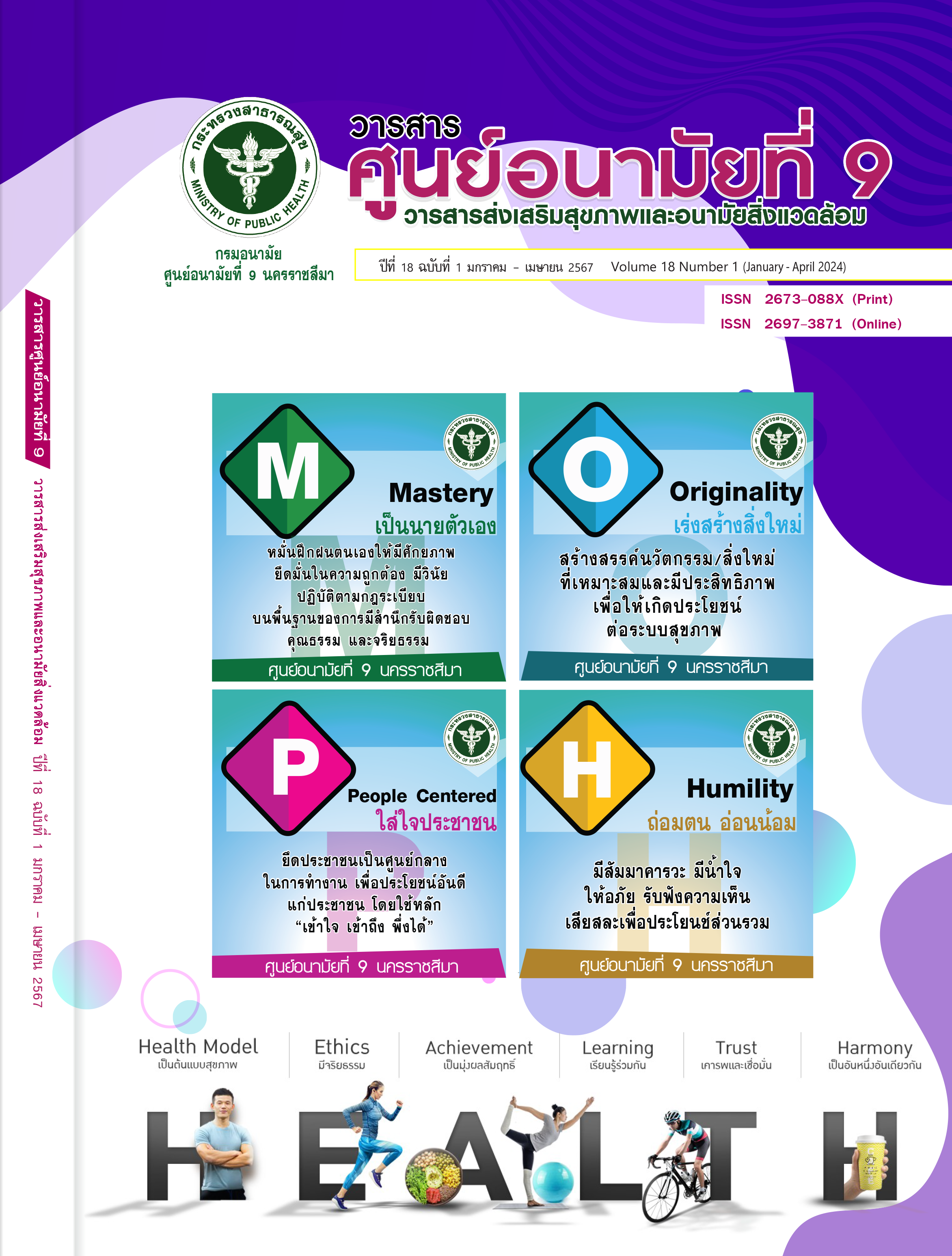การวิเคราะห์ข้อมูลโรคไข้เลือดออกของความแตกต่าง ระหว่างพื้นที่เขตเมืองและเขตชนบท ด้วยระบบสารสนเทศทางภูมิศาสตร์
คำสำคัญ:
โรคไข้เลือดออก, ระบบสารสนเทศทางภูมิศาสตร์, การวิเคราะห์ข้อมูล, เขตเมือง, เขตชนบทบทคัดย่อ
การวิเคราะห์ข้อมูลโรคไข้เลือดออกของความแตกต่างระหว่างพื้นที่เขตเมืองและเขตชนบท เป็นการเชื่อมโยงข้อมูลพื้นที่ ที่ต้องการด้วยระบบสารสนเทศทางภูมิศาสตร์ ทำให้ผู้อ่านได้เห็นถึงความแตกต่างระหว่างพื้นที่ จากเส้น จุดต่างๆ และโพลีกอนของพื้นที่นั้นๆ ซึ่งสามารถสะท้อนมุมมองใหม่ และสามารถเห็นภาพชัดเจนมากยิ่งขึ้น สามารถนำมาประยุกต์ใช้ได้จริงในการตรวจคัดกรองโรค การเฝ้าระวังโรค การป้องกันและควบคุมโรค การวางแผนการรักษาโรค และการฟื้นฟูสภาพของโรคไข้เลือดออกได้ โดยมีวัตถุประสงค์เพื่ออธิบายคุณลักษณะและกำหนดปัจจัยเสี่ยงต่างๆ ทางด้านประชากรศาสตร์ ด้านเศรษฐกิจ สังคม และด้านนิเวศวิทยาของโรคไข้เลือดออก เพื่อนำไปประยุกต์ใช้ในการทำนาย การระบาดของโรคไข้เลือดออกได้อย่างถูกต้องและแม่นยำ เป็นมุมมองสำหรับผู้บริหาร ผู้กำหนดนโยบาย นักวิชาการ และผู้สนใจ ในยุคดิจิตอล ดิสรับชัน (Digital disruption) สามารถใช้ข้อมูลเหล่านี้ เพื่อไปพัฒนาต่อยอดฐานข้อมูลการวางแผนโดยใช้องค์ความรู้การวิเคราะห์ข้อมูลทางเทคโนโลยีสมัยใหม่ และใช้ในการตัดสินใจเลือกพื้นที่เพื่อบริหารจัดการโครงการต่างๆ ในประเด็นของความแตกต่างระหว่างพื้นที่ในอนาคต ได้ตรงเป้าหมายมากที่สุด
เอกสารอ้างอิง
Chareonsook O, Foy HM, Teeraratkul A, Silarug N. Changing epidemiology of dengue hemorrhagic fever in Thailand. Epidemiology and Infection. 1999;122(1):161-6.
Clark DV, Mammen MP, Nisalak A, Puthimethee V, Endy TP. Economic impact of dengue fever/dengue hemorrhagic fever in Thailand at the family and population levels. The American journal of tropical medicine and hygiene. 2005;72(6):786-91.
Dijkstra EW. A note on two problems in connexion with graphs. Numerische mathematik. 1959;1(1):269-71.
Barbehenn M. A note on the complexity of Dijkstra's algorithm for graphs with weighted vertices. IEEE transactions on computers. 1998;47(2):263.
Demb JB. Multilevel Factors in Cancer Screening [dissertation]. San Francisco, CA: University of California, San Francisco; 2018.
Shariff-Marco S, Breen N, Stinchcomb DG, Klabunde CN. Multilevel predictors of colorectal cancer screening use in California. The American journal of managed care. 2013;19(3):205.
Krieger N, Chen JT, Waterman PD, Soobader M-J, Subramanian S, Carson R. Geocoding and monitoring of US socioeconomic inequalities in mortality and cancer incidence: does the choice of area-based measure and geographic level matter? the Public Health Disparities Geocoding Project. American journal of epidemiology. 2002;156(5):471-82.
Martin V, Pfeiffer DU, Zhou X, Xiao X, Prosser DJ, Guo F, et al. Spatial distribution and risk factors of highly pathogenic avian influenza (HPAI) H5N1 in China. PLoS pathogens. 2011;7(3):e1001308.
Lopez D, Gunasekaran M, Murugan BS, Kaur H, Abbas KM, editors. Spatial big data analytics of influenza epidemic in Vellore, India. 2014 IEEE international conference on big data (Big Data); 2014: IEEE.
Gilbert M, Chaitaweesub P, Parakamawongsa T, Premashthira S, Tiensin T, Kalpravidh W, et al. Free-grazing ducks and highly pathogenic avian influenza, Thailand. Emerging infectious diseases. 2006;12(2):227.
Zheng J, Zhang Z, Ciepłuch B, Winstanley AC, Mooney P, Jacob R, editors. A PostGIS-based pedestrian way finding module using OpenStreetMap data. 2013 21st International Conference on Geoinformatics; 2013: IEEE.
Lethanh N, Adey BT, Burkhalter M. Determining an optimal set of work zones on large infrastructure networks in a GIS framework. Journal of infrastructure systems. 2018;24(1):04017048.
Adger WN. Social and ecological resilience: are they related? Progress in human geography. 2000;24(3):347-64.
Galpern P, Ladle A, Uribe FA, Sandalack B, Doyle-Baker P. Assessing urban connectivity using volunteered mobile phone GPS locations. Applied Geography. 2018;93:37-46.
Shortliffe EH, Cimino JJ. Biomedical informatics: Computer applications in health care and biomedicine: Fourth edition: Springer London; 2014. 1-965 p.
Chadha C, Garg S, editors. Shortest path analysis on geospatial data using PgRouting. International Conference on Innovative Computing and Communications; 2019: Springer.
Ghanadian SA, Ghanbartehrani S. Application of Social Network Analysis in Evaluating Risk and network resilience of Closed-Loop-Supply-Chain. arXiv preprint arXiv:211000652. 2021.
Choosumrong S, Raghavan V, editors. REAL-TIME COST UPDATES BASED ON CURRENT TRAFFIC CONDITION FOR OPTIMAL ROUTING PLANNING. Proceedings of The 32nd Asian Conference on Remote Sensing (ACRS 2011), Taipei, Taiwan; 2011.
Buafueang P. A study of the application of Geographic Information System (GIS) for studying the spread of Dengue Haemorrhagic Fever (DHF) outbreak within Tamai District, Chanthaburi. 2013: 1-118.
กรมอุตุนิยมวิทยา. คู่มือการประยุกต์ใช้ระบบสารสนเทศภูมิศาสตร์ (GIS) เพื่อการนำเสนอข้อมูลอุตุนิยมวิทยา; 2560; 1-101.
ดาวน์โหลด
เผยแพร่แล้ว
รูปแบบการอ้างอิง
ฉบับ
ประเภทบทความ
สัญญาอนุญาต
ลิขสิทธิ์ (c) 2023 วารสารศูนย์อนามัยที่ 9 : วารสารส่งเสริมสุขภาพและอนามัยสิ่งแวดล้อม

อนุญาตภายใต้เงื่อนไข Creative Commons Attribution-NonCommercial-NoDerivatives 4.0 International License.
บทความหรือข้อคิดเห็นใด ๆ ที่ประกฎในวารสารศูนย์อนามัยที่ 9 เป็นความคิดเห็นของผู้เขียน บรรณาธิการ คณะผู้จัดทำ และศูนย์อนามัยที่ 9 นครราชสีมา (เจ้าของ) ไม่จำเป็นต้องเห็นด้วย ผู้เขียนต้องรับผิดชอบต่อบทความของตนเอง
ผลการพิจารณาของกองบรรณาธิการและผู้ทรงคุณวุฒิถือเป็นที่สิ้นสุด คณะบรรณาธิการวารสารฯ ขอสงวนสิทธิ์ในการตรวจแก้ไขข้อความให้ถูกต้องตามหลักภาษาและมีความเหมาะสม
กองบรรณาธิการวารสารฯ ขอสงวนสิทธิ์มิให้นำเนื้อหาใด ๆ ของบทความ หรือข้อคิดเห็นใด ๆ ของผลการประเมินบทความในวารสารฯ ไปเผยแพร่ก่อนได้รับอนุญาตจากกองบรรณาธิการ อย่างเป็นลายลักษณ์อักษร และผลงานที่ได้รับการตีพิมพ์ถือเป็นลิขสิทธิ์ของวารสารศูนย์อนามัยที่ 9


